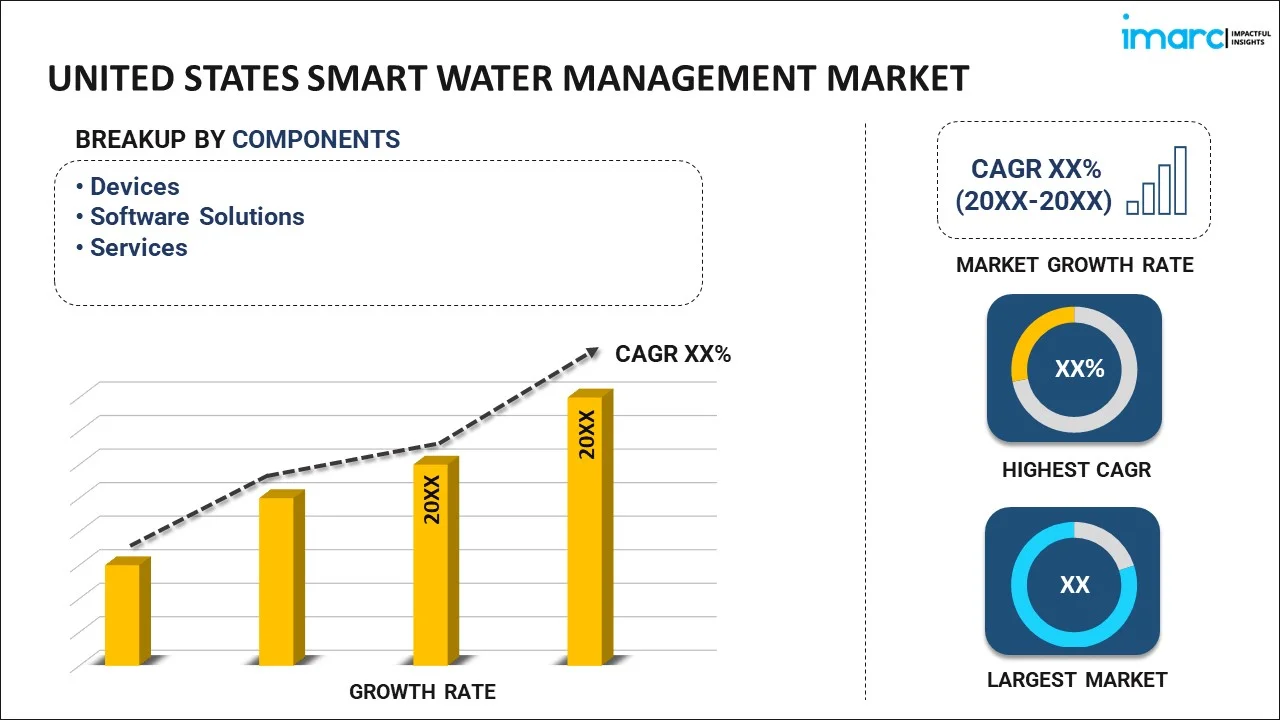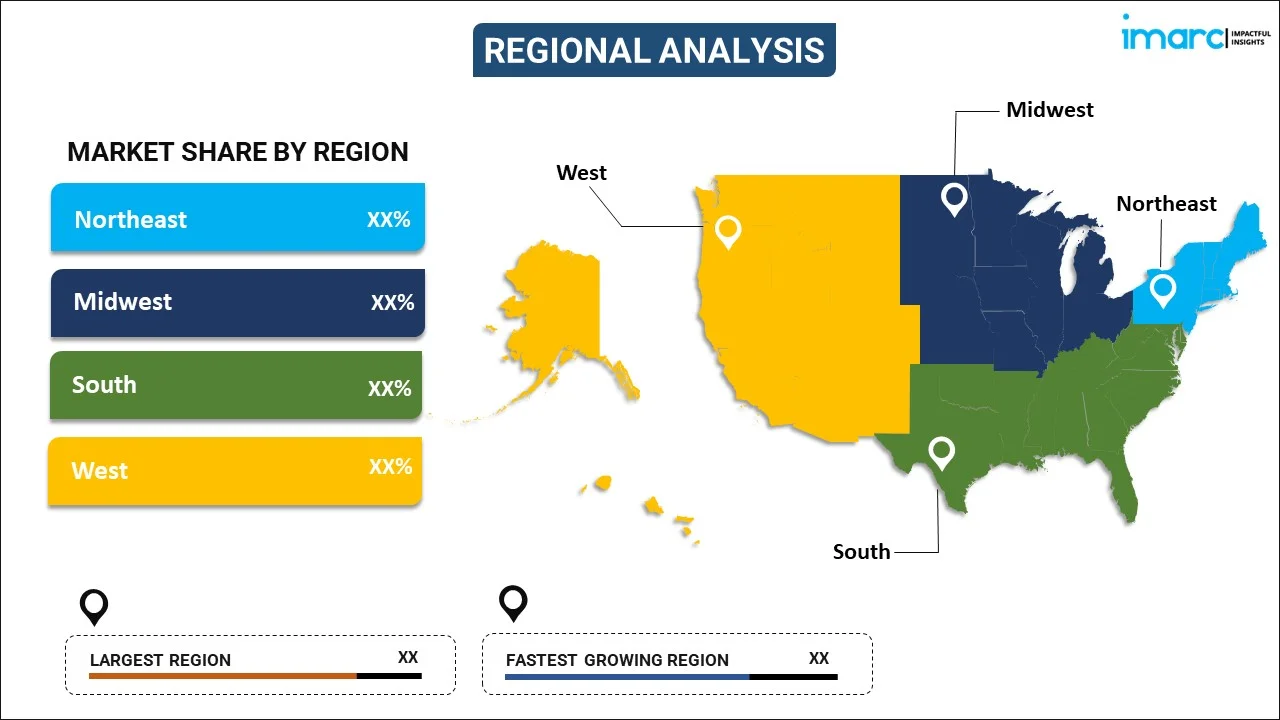
United States Smart Water Management Market Report by Component (Devices, Software Solutions, Services), Application (Residential, Commercial and Industrial), and Region 2024-2032
Market Overview:
United States smart water management market size is projected to exhibit a growth rate (CAGR) of 11.80% during 2024-2032. The increasing demand for sensor technologies and data analytics, which enable real-time monitoring, data analysis, and the automation of water distribution systems, improving overall efficiency, is driving the market.
|
Report Attribute
|
Key Statistics
|
|---|---|
|
Base Year
|
2023 |
|
Forecast Years
|
2024-2032 |
|
Historical Years
|
2018-2023
|
| Market Growth Rate (2024-2032) | 11.80% |
Smart water management involves the application of advanced technologies to efficiently and sustainably monitor, control, and optimize water usage. By leveraging sensors, data analytics, and communication technologies, smart water management systems enable real-time monitoring of water quality, consumption patterns, and infrastructure conditions. These systems provide valuable insights to water utilities and authorities, facilitating prompt decision-making and proactive maintenance. Through the integration of Internet of Things (IoT) devices and smart meters, users can remotely monitor and manage water usage, detect leaks, and implement conservation measures. Additionally, predictive analytics and machine learning algorithms help forecast demand, prevent water loss, and enhance overall system resilience. Smart water management not only improves operational efficiency but also promotes water conservation, reduces costs, and contributes to sustainable water resource management in the face of growing water challenges.
United States Smart Water Management Market Trends:
The smart water management market in the United States is rapidly gaining traction, driven by an increasing awareness of the critical need for sustainable water usage. Governments and municipalities are recognizing the imperative to address water scarcity and ensure efficient water distribution, pushing the smart water management market forward. Furthermore, the escalating regional population and urbanization are exerting immense pressure on water resources, necessitating innovative solutions to monitor and manage water infrastructure effectively. Moreover, advancements in sensor technologies and the IoT have significantly contributed to the growth of smart water management. These technologies enable real-time monitoring of water quality, consumption, and distribution, fostering proactive measures to prevent water wastage and contamination. Additionally, the integration of artificial intelligence and data analytics enhances the predictive capabilities of smart water management systems, optimizing water usage patterns and minimizing losses in distribution networks. Furthermore, the imperative to meet sustainability goals and reduce operational costs acts as a strong driver for the adoption of smart water management solutions across industries. As businesses increasingly recognize the economic and environmental benefits of efficient water management, the market is poised for continuous expansion. In summary, a confluence of factors, including environmental concerns, technological advancements, and economic incentives, propels the regional smart water management market towards a future of intelligent and sustainable water resource utilization.
United States Smart Water Management Market Segmentation:
IMARC Group provides an analysis of the key trends in each segment of the market, along with forecasts at the country level for 2024-2032. Our report has categorized the market based on component and application.
Component Insights:

- Devices
- Advanced Water Meters
- Meter Read Technology
- Software Solutions
- Asset Management
- Distribution Network Monitoring
- Supervisory Control and Data Acquisition (SCADA)
- Meter Data Management (MDM)
- Advance Analytics
- Others
- Services
- Managed Services
- Professional Services
The report has provided a detailed breakup and analysis of the market based on the component. This includes devices (advanced water meters and meter read technology), software solutions (asset management, distribution network monitoring, supervisory control and data acquisition (SCADA), meter data management (MDM), advance analytics, and others), and services (managed services and professional services).
Application Insights:
- Residential
- Commercial and Industrial
A detailed breakup and analysis of the market based on the application have also been provided in the report. This includes the residential and commercial and industrial.
Regional Insights:

- Northeast
- Midwest
- South
- West
The report has also provided a comprehensive analysis of all the major regional markets, which include the Northeast, Midwest, South, and West.
Competitive Landscape:
The market research report has also provided a comprehensive analysis of the competitive landscape in the market. Competitive analysis such as market structure, key player positioning, top winning strategies, competitive dashboard, and company evaluation quadrant has been covered in the report. Also, detailed profiles of all major companies have been provided.
United States Smart Water Management Market Report Coverage:
| Report Features | Details |
|---|---|
| Base Year of the Analysis | 2023 |
| Historical Period | 2018-2023 |
| Forecast Period | 2024-2032 |
| Units | US$ Million |
| Scope of the Report | Exploration of Historical Trends and Market Outlook, Industry Catalysts and Challenges, Segment-Wise Historical and Future Market Assessment:
|
| Components Covered |
|
| Applications Covered | Residential, Commercial and Industrial |
| Regions Covered | Northeast, Midwest, South, West |
| Customization Scope | 10% Free Customization |
| Report Price and Purchase Option | Single User License: US$ 3699 Five User License: US$ 4699 Corporate License: US$ 5699 |
| Post-Sale Analyst Support | 10-12 Weeks |
| Delivery Format | PDF and Excel through Email (We can also provide the editable version of the report in PPT/Word format on special request) |
Key Questions Answered in This Report:
- How has the United States smart water management market performed so far and how will it perform in the coming years?
- What has been the impact of COVID-19 on the United States smart water management market?
- What is the breakup of the United States smart water management market on the basis of component?
- What is the breakup of the United States smart water management market on the basis of application?
- What are the various stages in the value chain of the United States smart water management market?
- What are the key driving factors and challenges in the United States smart water management?
- What is the structure of the United States smart water management market and who are the key players?
- What is the degree of competition in the United States smart water management market?
Key Benefits for Stakeholders:
- IMARC’s industry report offers a comprehensive quantitative analysis of various market segments, historical and current market trends, market forecasts, and dynamics of the United States smart water management market from 2018-2032.
- The research report provides the latest information on the market drivers, challenges, and opportunities in the United States smart water management market.
- Porter's five forces analysis assist stakeholders in assessing the impact of new entrants, competitive rivalry, supplier power, buyer power, and the threat of substitution. It helps stakeholders to analyze the level of competition within the United States smart water management industry and its attractiveness.
- Competitive landscape allows stakeholders to understand their competitive environment and provides an insight into the current positions of key players in the market.
Need more help?
- Speak to our experienced analysts for insights on the current market scenarios.
- Include additional segments and countries to customize the report as per your requirement.
- Gain an unparalleled competitive advantage in your domain by understanding how to utilize the report and positively impacting your operations and revenue.
- For further assistance, please connect with our analysts.
 Inquire Before Buying
Inquire Before Buying
 Speak to an Analyst
Speak to an Analyst
 Request Brochure
Request Brochure
 Request Customization
Request Customization




.webp)




.webp)












